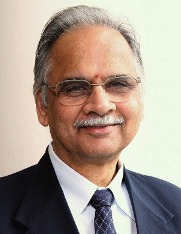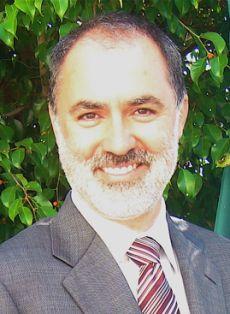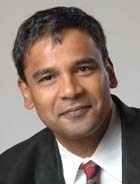Plenary Lectures
CCA Friday, September 10, 09:00-10:00, Room 501-502
From Sampled-Data Control to Signal Processing: Beyond the Shannon Paradigm
Yutaka Yamamoto
Kyoto University

Abstract: There has been remarkable progress in sampled-data control theory in the last two decades. The main achievement here is that there exists a digital (discrete-time) control law that takes the intersample behavior into account and makes the overall analog (continuous-time) performance optimal, in the sense of H-infinity norm. This naturally suggests its application to digital signal processing where the same hybrid nature of analog and digital is always prevalent. A crucial observation here is that the perfect band-limiting hypothesis, widely accepted in signal processing, is often inadequate for many practical situations. In practice, the original analog signals (sounds, images, etc.) are neither fully band-limited nor even close to be band-limited in the current processing standards. The problem is to interpolate high-frequency components beyond the so-called Nyquist frequency, and this is nothing but the intersample signals discarded through sampling. Assuming a natural signal generator model, sampled-data control theory provides an optimal platform for such problems. This new method has been implemented to a custom LSI chips by SANYO corporation, and has made success of producing over 12 million chips. This talk provides a new problem formulation, design procedure, and various applications in sound processing/compression and image processing.
Biography:
Dr. Yutaka Yamamoto received his Ph. D. degree in mathematics from the University of Florida, in 1978, under the guidance of Professor R. E. Kalman. He is currently professor in Department of Applied Analysis and Complex Dynamical Systems, Graduate School of Informatics, Kyoto University. His current research interests include the theory of sampled-data control systems, its application to digital signal processing, realization and robust control of distributed parameter systems and repetitive control. Dr. Yamamoto is a fellow of IEEE, and is the recipient of numerous prizes including G. S. Axelby outstanding paper award of IEEE Control Systems Society in 1996, Commendation of Science and Technology by the Ministry of Education of Japan in 2007. He was a past president of ISCIE, Japan, past vice President of IEEE Control Systems Society.
CACSD Wednesday, September 8, 09:00-10:00, Room 501-502
Modeling and Coping with Extremely Rare or Adverse Events
Mathukumalli Vidyasagar
The University of Texas at Dallas

Abstract: Extremely rare events occur in several areas of science and
engineering. Some examples are huge movements in the prices of assets
and commodities; and weather phenomena such as high winds and
hurricanes. Attempts to model these kinds of events using the law of
large numbers often fail because "rare" events seem to occur *far more
frequently* than a Gaussian distribution would suggest. In some areas,
such as clinical trials of drug candidates, a "law of large numbers"
will not apply because the available data is far too small to permit
the drawing of confident conclusions. For instance, one may have to
estimate a few dozen parameters on the basis of a few dozen samples
(whereas prudence would suggest at least a few thousand samples -- but
these are simply not available).
In this talk we give a *very elementary introduction* to some
theoretical methods for modeling and coping with extremely rare or
adverse events. To handle rare events, we suggest the use of "heavy
tailed" random variables, which have finite first moment but infinite
variance. The form of the "law of large numbers" for such variables,
and how these affect the design process, will be discussed. To model
adverse events with limited data, we suggest the use of "worst case
probability distributions" which can be formulated as a linear
programming problem, and often leads to surprisingly good insights.
Biography: Dr. Mathukumalli Vidyasagar was born in Guntur, India on September 29, 1947.
He received the B.S., M.S. and Ph.D. degrees in electrical engineering
from
the University of Wisconsin in Madison, in 1965, 1967 and 1969
respectively.
Between 1969 and 1989, he was a Professor of Electrical Engineering at
various universities in the USA and Canada. His last overseas job was
with the University of Waterloo, Waterloo, ON, Canada, where he served
between 1980 and 1989.
In 1989 he returned to India as the Director of the newly created
Centre for Artificial Intelligence and Robotics (CAIR) in Bangalore,
under the Ministry of Defence, Government of India.
Between 1989 and 2000, he built up CAIR into a leading research
laboratory
with about 40 scientists and a total of about 85 persons, working in
areas such as flight control, robotics, neural networks, and image
processing.
In 2000 he moved to the Indian private sector as an Executive Vice
President
of India's largest software company, Tata Consultancy Services.
In the city of Hyderabad, he created the Advanced Technology Center,
an industrial R&D laboratory of around 80 engineers, working in
areas such as computational biology, quantitative finance, e-security,
identity management, and open source software to support Indian
languages.
In 2009 he retired from TCS at the age of 62, and joined the Erik
Jonsson
School of Engineering & Computer Science at the University of Texas at
Dallas, as a Cecil & Ida Green Professor of Systems Biology Science.
In his latest incarnation, he conducts teaching and research in two
distinct
areas: computational biology and quantitative finance.
He is also actively involved in UTD's newly created or planned programs
in
Bio-Engineering and Systems Engineering & Management.
ISIC Thursday, September 9, 09:00-10:00, Room 501-502
Extremum Seeking for Nash Games in Financial and Energy Markets
Miroslav Krstic
University of California, San Diego

Abstract: In economic networks, behaviors that seem intelligently conceived (for the most part) emerge without a coordinating entity, but as a result of multiple agents pursuing self-interested strategies. Such behaviors have traditionally been interpreted using paradigms of non-cooperative game theory. However, standard game theory usually assumes that the players know the models of their own payoff functions and the actions of the other players. Relying on the method of extremum seeking, we design algorithms that do not need any modeling information and where, instead, the players employ only the measurements of their own payoff values. The extremum seeking algorithms are proved to converge to the Nash equilibria of the underlying non-cooperative games. In other words, extremum seeking allows the player to learn its Nash strategy. Extremum seeking algorithms are not restricted to games with a limited number of players but are, in fact, applicable to games with uncountably many players. While in finite games each player employing extremum seeking must employ a distinct probing frequency, a remarkable situation arises in games with uncountably many players - we show that, as long as any frequency is employed by countably many players, convergence to the Nash equilibrium is guaranteed. Such large (for all practical purposes uncountable) games arise in future energy trading markets involving households that own plug-in hybrid electric vehicles, whose battery capacity is used for the storage of energy during periods of excess production from wind and solar sources and for selling energy back to the grid, at a price, or in quantity, determined by a controller pursuing profit maximization for the household with the help of an extremum seeking algorithm.
Biography:
Dr. Miroslav Krstic is the Daniel L. Alspach Professor of Dynamic Systems and Control at University of California, San Diego, and the founding director of the Cymer Center for Control Systems and Dynamics at UCSD. He is a co-author of eight books, including the classic Nonlinear and Adaptive Control Design (1995), one of the two most cited research monographs in control theory, the new single-authored Delay Compensation for Nonlinear, Adaptive, and PDE Systems(466 pages, Birkhauser, October 2009), and other books on control of turbulent fluid flows, stochastic nonlinear systems, and extremum seeking. Krstic has held the Russell Severance Springer Distinguished Visiting Professorship at UC Berkeley and the Harold W. Sorenson Distinguished Professorship at UC San Diego. He is a recipient of the PECASE, NSF Career, and ONR Young Investigator Awards, as well as the Axelby and Schuck Paper Prizes. Krstic was the first recipient of the UCSD Research Award in the area of engineering. He is a Fellow of IEEE and IFAC and serves as Senior Editor in IEEE Transactions on Automatic Control and Automatica.
Thursday, September 9, 17:00-18:00, Room 501-502
2009 Awardee of IEEE CSS Transition to Practice Award
Computation: the emerging bottleneck in integrated circuit design and manufacture
Kameshwar Poolla
University of California, Berkeley
URL: http://www.eecs.berkeley.edu/Faculty/Homepages/poolla.html

Abstract: Moore's Law describes an important trend in the history of computer hardware: that the number of transistors that can be inexpensively placed on an integrated circuit is increasing exponentially, doubling approximately every two years. The self-fulfilling prophesy of Moore's Law is under threat. The new bottleneck comes not from hardware and technology capabilities, but from control, computation, and algorithmic constraints in various steps in the design flow such as verification and optical proximity correction.
In the first part of the talk, we describe our efforts in developing a new class of wireless sensors for use in semiconductor manufacturing. These sensors are fully self-contained with on board power, communications, and signal processing electronics. The sensors offer unprecedented spatial and time resolution, making them suitable for equipment diagnostics and design, and for process optimization and control. We will illustrate the applications of these sensors in IC processing, and describe our efforts at commercializing this technology.
In the second part of the talk, will outline three very large scale computational problems that are critical to next generation ICs. These are: Inverse lithography, design verification, and design-for manufacturability. We formulate these mathematically using the common language of clip calculus and show possible solutions. We will conclude with arguing for the vital importance of computation and modeling in this economically important field.
Biography: Dr. Kameshwar Poolla received the Bachelor of Technology degree from the Indian Institute of Technology, Bombay in 1980, and the Ph.D. degree from the University of Florida, Gainesville in 1984. He has served on the faculty of the Department of Electrical and Computer Engineering at the University of Illinois, Urbana from 1984 to 1991. Since then, he has been with the University of California, Berkeley where he is the Cadence Distinguished Professor of Mechanical Engineering and Electrical Engineering & Computer Sciences. He currently serves as the Director of the IMPACT center for Integrated Circuit manufacturing at the University of California. Dr. Poolla has also held visiting appointments at Honeywell, McGill University, M.I.T., Michigan, Columbia, and Padova. He has worked as a Field Engineer with Schlumberger on oilrigs in West Africa. In 1999, he co-founded OnWafer Technologies which offers metrology based yield enhancement solutions for the semiconductor industry. OnWafer was acquired by KLA-Tencor in 2007. He has also serves as a technology and mergers/acquisitions consultant for Cadence Design Systems. Dr. Poolla has been awarded a 1988 NSF Presidential Young Investigator Award, the 1993 Hugo Schuck Best Paper Prize, the 1994 Donald P. Eckman Award, the 1998 Distinguished Teaching Award of the University of California, and the IEEE Transactions on Semiconductor Manufacturing Best Paper Prizes in 2005 and 2007. Professor Poolla's research interests include System Identification, Robust Control, Semiconductor Manufacturing, Sensor Networks, and Medical Imaging.



